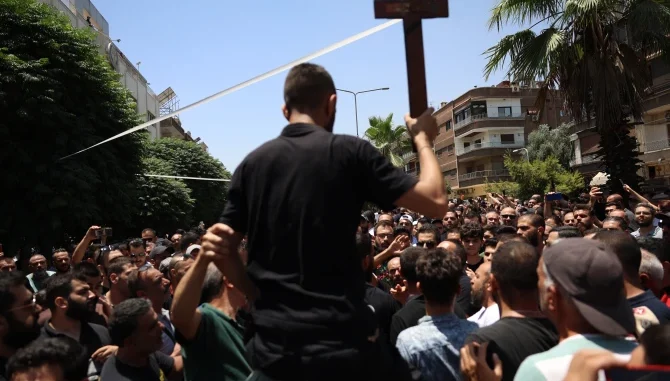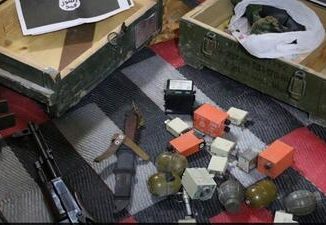
In a scene marked by deep sorrow and righteous anger, churches across Syria held funeral services for the victims of the suicide bombing that targeted St. Elias Church in the Syrian capital, Damascus. The attack claimed the lives of 25 people and left dozens injured. | Credit: Mohammad Al-Rifai/ACI MENA
| Published August 11, 2025
DAMASCUS / HOMS / SWEIDA, Syria — The dawn of June 22, 2025, was shattered by a horrific attack on St. Elias Greek Orthodox Church in Damascus: a suicide bomber struck during morning worship, claiming the lives of 22 people and injuring more than 60 others. The blast not only silenced voices raised in prayer—it resonated as a distressing signal of growing insecurity for one of the world’s oldest continuous Christian communities.
A Legacy in Retreat
Syria’s Christian communities are among the oldest in the world, tracing their roots back nearly two millennia to the earliest followers of Jesus Christ. For centuries, cities like Damascus, Aleppo, Homs, and the valleys of Wadi al-Nasara have been home to vibrant Christian populations who have preserved unique traditions, languages, and rites—ranging from the Greek Orthodox and Syriac Orthodox to Maronite and Armenian churches.
Before the outbreak of the civil war in 2011, Christians made up approximately 10% of Syria’s population, living alongside Muslims and other religious groups in a fragile but longstanding coexistence. These communities not only enriched Syria’s cultural and religious diversity but also contributed significantly to education, healthcare, and commerce.
However, the protracted conflict unleashed waves of violence, displacement, and social upheaval that have devastated these communities. Many Christians have fled their ancestral towns and villages, seeking refuge in safer parts of Syria or emigrating abroad. In regions like Idlib, where extremist factions gained control, the Christian presence has been almost entirely wiped out—reports estimate that as much as 90% of the Christian population there has fled since 2011.
The toll goes beyond numbers: entire neighborhoods once bustling with Christian life are now silent, churches have been destroyed or abandoned, and centuries-old religious festivals and practices have been disrupted or forgotten. The fabric of these communities is unraveling as families face impossible choices—whether to stay amid growing threats or to leave behind their heritage in search of security.
This retreat threatens to erase an irreplaceable chapter of Middle Eastern history. The slow but steady disappearance of Syria’s Christians risks transforming a land once marked by pluralism and tolerance into one where ancient voices fall silent.
Mounting Pressures
The recent surge in violence against Syria’s Christian communities has compounded years of fear, uncertainty, and hardship. The suicide bombing at St. Elias Greek Orthodox Church in Damascus starkly illustrates the existential threats these communities face. Survivors recount harrowing scenes of chaos—swollen and exploded bodies strewn across what should have been a sanctuary of peace—engraving deep psychological scars on those who lived through the attack.
Beyond physical violence, many Christians in Syria feel a growing sense of abandonment. Religious leaders have criticized government authorities for failing to officially observe mourning or to recognize the victims as martyrs, a sign of the marginalization these minorities endure even in moments of tragedy. This perceived neglect deepens the wounds inflicted by violence, leaving communities feeling invisible and unprotected by the state.
Moreover, the attacks are not isolated incidents. Reports from the Catholic News Agency reveal a troubling pattern of targeted aggression: St. Michael’s Church in Sweida was ransacked and set ablaze, while a foiled car-bomb attack against the Mar Elias Maronite Church in eastern Tartus underscores the persistent threat of extremist violence. Such incidents increase anxiety and fuel an atmosphere of insecurity that permeates daily life.
Christians also face indirect pressures that exacerbate their vulnerability. The threat of forced conscription into military or paramilitary groups weighs heavily on young men. Many families resort to paying exorbitant sums to avoid conscription or to secure passage abroad through smugglers, often risking their lives in dangerous journeys. Economic hardship, compounded by war and sanctions, disproportionately affects minorities, reducing opportunities and pushing many to contemplate emigration as the only viable option.
This combination of direct attacks, social marginalization, and economic strain has created a suffocating environment, where the future of Syria’s Christian communities grows increasingly precarious.
The Exodus Gains Momentum
As violence escalates and daily life becomes increasingly precarious, the flight of Syria’s Christian communities from their ancestral homeland is accelerating. For many families, staying in Syria has become a painful dilemma—cling to roots that have endured for centuries, or seek uncertain refuge abroad.
Younger generations, in particular, are weighing their options carefully. Many dream of safer futures beyond Syria’s borders, motivated by the desire for security, education, and economic opportunity—things that have grown scarce in their war-torn country. Churches and aid organizations report a steady rise in the number of youth applying for visas or paying smugglers to cross perilous borders into Lebanon, Turkey, and further into Europe.
The journey is fraught with risk. Families often face extortionate fees demanded by human traffickers and must navigate hostile checkpoints, dangerous terrains, and overcrowded refugee camps. Yet, for many, the peril is preferable to the daily threats of bombings, kidnappings, and forced conscription back home. Avoiding military service has become another driver of migration; Christian families often pay hefty bribes or seek escape routes to prevent their sons from being drafted into ongoing conflicts or militia groups.
As these waves of emigration swell, the demographic landscape within Syria shifts dramatically. Areas that were once hubs of Christian cultural life—such as the villages of Wadi al-Nasara or the historically rich town of Maaloula—now see empty homes, shuttered churches, and a diminished communal life.
This ongoing exodus also impacts the diaspora communities abroad, which have grown in size and influence. While these communities offer a lifeline and preserve Syrian Christian traditions outside the homeland, their growth also highlights the deepening disconnect from Syria itself. The loss of youth and professionals erodes the community’s ability to rebuild internally and risks severing the continuous line of cultural and religious transmission.
Without concerted efforts to restore safety and provide economic opportunity, the momentum of this exodus threatens to render Syria’s Christian presence a distant memory, confined mostly to history books and scattered expatriate enclaves.
Is Syria Losing Its Christian Heritage?
Syria’s Christian heritage is a treasure trove of ancient faith, culture, and history that dates back to the earliest days of Christianity. This land witnessed some of the first Christian communities established outside of Jerusalem, and its churches—like those in Maaloula, Saydnaya, and the ancient cities of Aleppo and Damascus—are living monuments to a faith that has endured conquests, empires, and centuries of change.
Yet today, this precious heritage stands at a crossroads. The relentless violence and persecution of recent years threaten not only the people but also the very legacy they embody. As Christian families flee, churches lose congregations; monasteries face abandonment; ancient liturgical languages like Syriac are spoken by fewer and fewer people. The vibrant tapestry of rituals, festivals, and community life that once defined Syria’s Christians is unraveling.
The demographic decline is stark. From approximately 1.5 million Christians before the civil war to fewer than 300,000 today, the rapid shrinkage signals more than just a population crisis—it marks a profound cultural rupture. This shift jeopardizes centuries of religious coexistence and mutual influence between Christians and other religious groups in Syria.
Moreover, the loss is not confined to physical presence. The disappearance of Christians from Syria would mean the loss of unique theological traditions, sacred music, manuscript collections, and distinctive art and architecture that have shaped Middle Eastern Christianity and enriched global heritage.
International observers and heritage preservationists warn that if current trends continue unchecked, Syria’s Christian heritage risks becoming an artifact of the past rather than a living tradition. The destruction of churches during fighting, the neglect of holy sites, and the fading of community life combine to threaten one of Christianity’s most ancient continuous presences.
This is not merely a local tragedy but a loss for humanity as a whole—a silencing of voices that have contributed to the religious and cultural mosaic of the Middle East. The question now stands stark: will Syria’s Christian heritage survive this chapter of conflict, or will it become another casualty of war?
A Plea for Recognition and Support
In the face of escalating violence and the steady erosion of their communities, Syria’s Christian leaders and faithful are raising urgent calls for recognition, protection, and solidarity—both within Syria and on the global stage. Patriarch John X of Antioch, one of the most prominent voices of Syrian Christianity, has repeatedly implored international governments, religious organizations, and humanitarian agencies to not overlook the plight of these ancient communities.
“Our roots run deep in this land,” the Patriarch declared during recent memorial services. “Christians have contributed to Syria’s cultural, social, and spiritual fabric for nearly two thousand years. To abandon them now would be to erase a vital part of Syria’s identity and history.”
Local clergy emphasize that the issue goes beyond security concerns; it is about dignity, justice, and the right to live in peace within their homeland. Many feel marginalized by state authorities who have been slow or unwilling to publicly acknowledge the targeting of Christians or to declare national mourning after attacks on churches. This perceived silence fuels feelings of isolation and vulnerability.
Internationally, advocacy groups warn that without focused attention and concrete action, the gradual disappearance of Syria’s Christians will accelerate, becoming irreversible. They urge foreign governments to support policies that facilitate humanitarian aid, offer asylum to those fleeing persecution, and help rebuild shattered communities. There is also a call for preservation initiatives to protect religious sites and cultural heritage that are at risk of destruction or neglect.
Faith leaders stress that protecting Syria’s Christians is not merely a sectarian issue but a universal human rights concern. The preservation of religious pluralism and minority rights in Syria is critical for the country’s long-term stability and the hope of reconciliation after years of conflict.
Ultimately, this plea is a call for empathy, recognition, and action—affirming that Syria’s Christian communities are not relics of the past but living, vital parts of the nation’s future. The world’s response in the coming months and years will determine whether these communities survive, thrive, or fade into history.
Why This Issue Matters
-
Historical Significance: Syria is home to one of Christianity’s earliest and longest-standing communities—a living link to the faith’s roots.
-
Humanitarian Imperative: These are not just matters of faith, but of survival. The targeted violence and lack of protection underscore a humanitarian crisis.
-
Global Responsibility: As these communities face silence and neglect, international observers and governments must listen, acknowledge, and act—not merely as geopolitical spectators, but as defenders of ancient heritage and human dignity.
 Implications of Syria’s Escalating Violence Against Christians
Implications of Syria’s Escalating Violence Against Christians
Here are the implications drawn from the situation described in those reports—covering political, social, cultural, and geopolitical dimensions:
1. Cultural and Historical Erasure
-
The loss of Syria’s ancient Christian communities is not just a demographic shift—it’s the erosion of a living heritage that has existed for nearly 2,000 years.
-
Once these populations are displaced, the churches, monasteries, and traditions tied to them risk becoming empty monuments rather than active centers of worship.
-
Future generations may only know these communities through archives and ruins, not living testimony.
2. Accelerated Emigration and Brain Drain
-
Each attack drives more families—especially youth and skilled professionals—to emigrate.
-
This weakens Syria’s human capital, making post-war economic recovery harder and leaving behind an older, more vulnerable population.
-
Christian emigration also shifts the Middle Eastern diaspora, concentrating ancient communities in Western countries while depleting their homeland presence.
3. Sectarian Deepening and Polarization
-
Targeted attacks reinforce a sectarian narrative in Syria’s fragile post-war fabric, further polarizing religious communities.
-
This can fuel retaliatory attitudes, hinder reconciliation efforts, and sustain cycles of mistrust between minority and majority groups.
4. Weakening of Religious Pluralism in the Middle East
-
The departure of Christians from Syria mirrors trends in Iraq, Lebanon, and parts of Egypt—shrinking religious diversity across the Levant.
-
This reduces the cultural mosaic that has historically been a hallmark of the region, leading to more religiously homogenous but less tolerant societies.
5. Geopolitical and Propaganda Risks
-
Regional powers and extremist groups could use the persecution narrative for propaganda—either to recruit fighters, justify interventions, or rally international sympathy selectively.
-
Western governments may face increased pressure from diaspora groups to intervene or provide asylum, potentially altering refugee and migration policy.
6. Economic and Tourism Impact
-
Many of Syria’s Christian regions—such as Maaloula and Wadi al-Nasara—are tied to religious tourism and heritage sites.
-
Ongoing violence damages infrastructure, discourages visitors, and deprives local economies of much-needed income.
7. Moral and Diplomatic Pressure on the International Community
-
The lack of strong global response risks normalizing violence against religious minorities.
-
If unaddressed, it signals that ancient heritage and minority rights are secondary to geopolitical interests, weakening international human rights credibility.
 Overall Takeaway:
Overall Takeaway:
The escalating violence against Syria’s ancient Christian communities is not merely an isolated security issue—it represents a profound threat to the cultural fabric, religious diversity, and historical legacy of the Middle East. As these communities face extinction through targeted attacks, forced displacement, and ongoing neglect, Syria risks losing a vital part of its identity that has withstood millennia of change.
Without urgent international attention and meaningful protection, the gradual erasure of these Christians will accelerate, deepening sectarian divides and weakening the pluralism that once defined the region. Preserving Syria’s Christian heritage is a moral imperative—not only for the survival of these communities but for the broader hope of coexistence and reconciliation in a post-conflict Syria.
The world must listen to the pleas of those left behind and recognize that the loss of Syria’s Christians would be a loss for all humanity.
SOURCES: RELIGION UNPLUGGED – Special Report: Syria’s Ancient Christian Communities Face Extinction As Violence Escalates
CATHOLIC NEWS AGENCY – Violence against Christians escalates in Syria





Be the first to comment